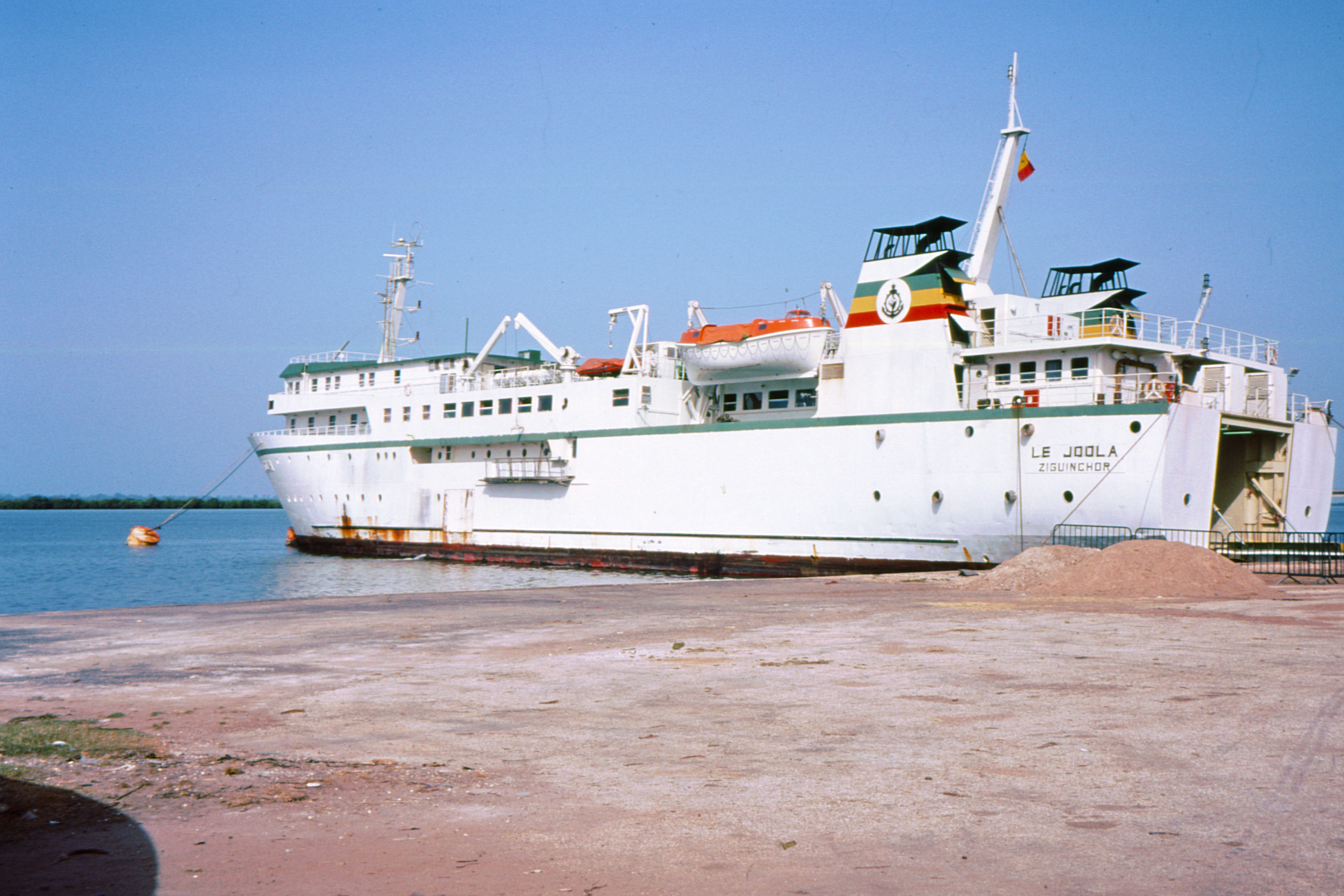|
MV Le Joola
MV ''Le Joola'' was a Senegalese government-owned roll-on/roll-off ferry that capsized off the coast of The Gambia on 26 September 2002, with 1,863 deaths and 64 survivors. It is thought to be the second-worst non-military disaster in maritime history. The ship was plying the route from Ziguinchor in the Casamance region to the Senegalese capital, Dakar, when it ran into a violent storm, farther out to sea than it was licensed to sail. The estimated 2,000 passengers aboard (about half of whom lacked tickets) would have amounted to nearly four times the ship's design load. The large numbers sleeping on-deck (and thus above its center of buoyancy) added further instability. Rescue operations did not start for several hours. A government inquiry principally blamed negligence, and accusations were levelled at both the Senegalese president Abdoulaye Wade and prime minister Mame Madior Boye. The ship The ship was named ''Le Joola'' after the Jola people of southern Senegal. Constr ... [...More Info...] [...Related Items...] OR: [Wikipedia] [Google] [Baidu] |
Babacar Gaye
Babacar Gaye (born 31 January 1951) is a Senegalese Army General who was the former United Nations Secretary-General's Special Representative and Head of the United Nations Multidimensional Integrated Stabilization Mission in the Central African Republic (MINUSCA). Prior to this appointment of 16 July 2014, he was the Special Representative and Head of the United Nations Integrated Peacebuilding Office for the Central African Republic (BINUCA). Career In August 2010, he was appointed by United Nations Secretary-General Ban Ki-moon as the Military Advisor for Peacekeeping Operations in New York UN Headquarters replacing Nigeria's Lieutenant General Chikadibia Isaac Obiakor. In 2005, The Secretary-General, Kofi Annan, appointed Lieutenant-General Babacar Gaye (Senegal) as the new Force Commander of the United Nations Organization Mission in the Democratic Republic of the Congo (MONUC). He replaced Major-General Samaila Iliya (Nigeria) and was the third Force Commander of MONUC an ... [...More Info...] [...Related Items...] OR: [Wikipedia] [Google] [Baidu] |
Moustapha Niasse
Moustapha Niasse (born November 4, 1939 .) is a Senegalese politician and diplomat who has been List of presidents of the National Assembly of Senegal, President of the National Assembly from 2012 until 2022. He served in the government of Senegal as Foreign Minister of Senegal from 1978 to 1984 and again from 1993 to 1998. He was Prime Minister of Senegal for a few weeks in 1983, and he held that position again from 2000 to 2001. Early life and education Niasse was born in Keur Madiabel, Senegal. Graduated from Cheikh Anta Diop University and University of Paris.Political career He was Director of the Presidential Cabinet from 1970 to 1979. In March 1979, he became Minister of Town Planning, Housing and Environment, serving in that position until September 1979,[...More Info...] [...Related Items...] OR: [Wikipedia] [Google] [Baidu] |
Armed Forces Of Senegal
The Armed Forces of Senegal (french: Forces armées du Sénégal) consists of about 17,000 personnel in the army, air force, navy, and gendarmerie. The Senegal military force receives most of its training, equipment, and support from France and the United States. Germany also provides support but on a smaller scale. Military noninterference in political affairs has contributed to Senegal's stability since independence. Senegal has participated in many international and regional peacekeeping missions. Most recently, in 2000, Senegal sent a battalion to the Democratic Republic of Congo to participate in MONUC, the United Nations peacekeeping mission. Senegal also agreed to deploy a United States-trained battalion to Sierra Leone to participate in UNAMSIL, another UN peacekeeping mission. The training operation was designated Operation Focus Relief and involved U.S. Army Special Forces from 3rd Special Forces Group training a number of West African battalions, including Nigerian one ... [...More Info...] [...Related Items...] OR: [Wikipedia] [Google] [Baidu] |
Kabadio
Kabadio is a village in the rural commune of Kataba I, in the Bignona Department of the Ziguinchor Region Ziguinchor is a region of Senegal (regional capitals have the same name as their respective regions). The region is also referred to historically and popularly as Basse Casamance , settlement_type = Geographical region , image_skylin ... of southwestern Senegal. In 2002 it had a population of 1501 people. References Populated places in the Bignona Department {{Senegal-geo-stub ... [...More Info...] [...Related Items...] OR: [Wikipedia] [Google] [Baidu] |
Haïdar El Ali
Haidar el Ali is a Senegalese ecologist, appointed Minister of Ecology in April 2012. In 2013 he became the Minister of Fisheries. He is also president of the Senegalese Green Party Senegal,; Wolof: ''Senegaal''; Pulaar: 𞤅𞤫𞤲𞤫𞤺𞤢𞥄𞤤𞤭 (Senegaali); Arabic: السنغال ''As-Sinighal'') officially the Republic of Senegal,; Wolof: ''Réewum Senegaal''; Pulaar : 𞤈𞤫𞤲𞤣𞤢𞥄𞤲𞤣𞤭 � ... (FEDES). 5 April 2012 References Ecologists[...More Info...] [...Related Items...] OR: [Wikipedia] [Google] [Baidu] |
Coastal Waters
The coast, also known as the coastline or seashore, is defined as the area where land meets the ocean, or as a line that forms the boundary between the land and the coastline. The Earth has around of coastline. Coasts are important zones in natural ecosystems, often home to a wide range of biodiversity. On land, they harbor important ecosystems such as freshwater or estuarine wetlands, which are important for bird populations and other terrestrial animals. In wave-protected areas they harbor saltmarshes, mangroves or seagrasses, all of which can provide nursery habitat for finfish, shellfish, and other aquatic species. Rocky shores are usually found along exposed coasts and provide habitat for a wide range of sessile animals (e.g. mussels, starfish, barnacles) and various kinds of seaweeds. Along tropical coasts with clear, nutrient-poor water, coral reefs can often be found between depths of . According to a United Nations atlas, 44% of all people live within 5 km (3.3mi) of ... [...More Info...] [...Related Items...] OR: [Wikipedia] [Google] [Baidu] |


